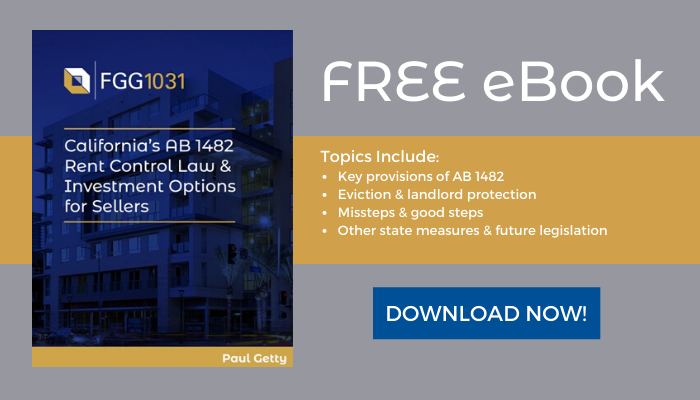In this third post in our series on the impact of California’s new Tenant Protection Act of 2019, Paul Getty, founder and CEO of First Guardian Group shares his perspective on the challenges that landlords face with the new eviction definitions.
Q. Let’s explore the new rules around eviction and the Act’s definitions for ‘just cause.’ What do you see are the greatest implications for landlords?
A. Well, the biggest implication from my perspective, is when you go through 1482, there are a number of provisions that relate to how a landlord can remove tenants. Those provisions fall into two categories. The first if “just cause” where a tenant is at fault for doing something the landlord believes they shouldn’t be doing. The most obvious example of that is failing to pay rent. That is probably the only black and white provision that few would dispute. But there are several other provisions that are not as clear-cut. Examples would be “committing waste” or “becoming a commission of a nuisance”, and 5-6 others that reference other codes in California law that landlords must become familiar with.
Because these areas of the law are not exceptionally clear, a landlord will probably have to secure the services of an attorney to render an opinion. If a tenant challenges a landlord who states the tenant is committing waste and the tenant says they’re not, the landlord will need to secure a lawyer in order to take the tenant to court. Since terms like “committing waste” or “becoming a commission of nuisance” are not well defined in statutes, they become “grey areas” where tenants can argue over interpretation, and landlords will be forced to protect their interests by hiring attorneys.
The other provisions are where tenants are not at fault, referred to as no-fault provisions, where the landlord and tenant agree that no fault has occurred, the tenant leaves and everything is fine. If there is a government order that necessitates vacating a property – for example an earthquake – and the property is deemed not habitable per government definition, that could be another example of a situation where no party is at fault, and the landlord could remove a tenant. If the landlord or a relative of the landlord intends to occupy the property, that’s another example of a no-fault exclusion where the landlord can take possession of the property without any repercussions.
These types of regulations have been around at local levels for quite some time but this truly the first time we’ve seen the collection of at-fault and no-fault provisions being propagated at a state level.
Q. Paul, with the ambiguity in these definitions you’ve just highlighted, do you see this sparking a whole new wave of legal wrangling amongst landlords and tenants.
A. There’s no question about it. We are seeing in areas like Sacramento and San Francisco law practices openly advertising for tenants and in many cases with a willingness to take cases of dispute on a contingency basis, so the tenants aren’t obligated to pay out-of-pocket expenses for the attorney. We see an increasing effort among these tenant attorneys pursuing landlords who have deep pockets or insurance policies, or both. And they’re basically making a case in front of the court that tenant’s rights have been compromised. Because the courts in California tend to favor tenants over landlords, in many cases now, landlords are having to pay up for lawsuits that are without merit or with very little merit.
Our next post highlights actions Paul suggests landlords take in order to comply with all the requirements of AB 1482.
If you have any questions, please feel free to reach out to Paul directly at 866-398-1031 or schedule some time on Paul’s calendar.
Also, check out our latest ebook, California's AB 1482 Rent Control Law & Investment Options for Sellers today!









Your Comments :